
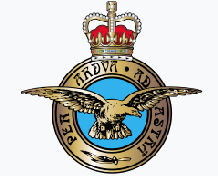
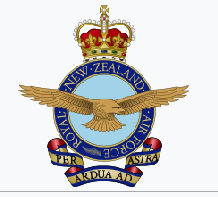
F/Lt Ross Victor Allan Levy RNZAF - Pilot
P/O Wilfred George Atkinson RAFVR - Engineer
F/Sgt Albert James Coveney RAFVR - Wireless Operator / Gunner
Sgt Patrick Kelly RAFVR - Gunner (possibly Kelley)
F/O James William Stigger RAFVR - Air Bomber
Please note that as of December, 2019 some of the links above are broken. As of September 2020, attempts to relocate the various elements of data and restore working links to them have been unsuccessful, nevertheless I shall contine to work on them.
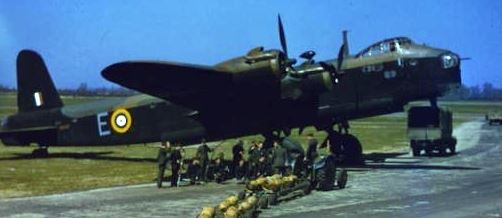
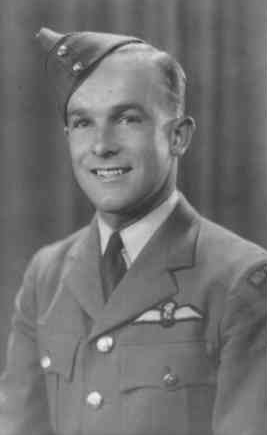 Flight Lieutenant Ross Levy, RNZAF. Image obtained from Auckland Museum Cenotaph web page, and used with their kind permission. You MUST request their permission before using this image yourself.
Flight Lieutenant Ross Levy, RNZAF. Image obtained from Auckland Museum Cenotaph web page, and used with their kind permission. You MUST request their permission before using this image yourself.
There appears to be no remaining tangible evidence of the crash on the west side of Potton, involving Stirling IV identification LK207, MA-W on Thursday, 19th October 1944 piloted by Flt Lt Ross Levy RNZAF of 161 Squadron, for 3 Group out of Tempsford.
It seems the crew were carrying out a flight test on the recently delivered aircraft when it broke up over the town, and fell in two large pieces, all the crew being killed. A farmer friend, sadly no longer with us, remembered this crash vividly, as it occurred near his school. He recalled the schoolchildren made up special notices for each of the crew, and I had hoped there may be some of this history remaining at the school, but it seems to have been disposed of in a later clear up.
It is possible this aircraft had been involved in a heavy landing only a few days before, and was on a trial flight. It is reported that despite facing imminent death, the pilot wrestled the front fuselage of the plane away from Potton School and saved countless schoolchildren's lives. I do not believe he was sufficiently posthumously rewarded or recognised for this incredible action.
In around 2001, I believe an attempt to locate the wreck site was made, but apparently without success. I am not sure just where the search was conducted, but I believe the placement of the crash site might be very close to what is (at present, anyway) the streets Nursery Close and Langley Gardens. However, there is much confusion between the two Potton Stirling crashes, LK207 and LK236, and I am pretty sure some people have mixed them up in their very old memories. I think the RAF may have records that could be helpful in separating the two incidents; nevertheless, there is evidence that the major wreckage from both aircraft did indeed fall in close proximity to each other. LK236 is described in some sources as crashing at Deepdale in Potton; LK207 as crashing just north of Mrs. Langley's Nurseries alongside the B1042 Potton to Sandy Road, and these places are quite close.
A contact James Dagwell, spoke to his stepfather, who recalled ploughing the field where now the housing development resides, and turning up pieces of the Stirling. This suggests the location to be slightly further south than I have put it in my map below, but on the other hand, I guess small pieces of wreckage would be well scattered, both in the crash and during the subsequent recovery of the wreckage by the RAF.
Click on this link to view a map of the west side of Potton, showing where the two planes LK207 (in red) and LK236 (in green) fell - in MY interpretation! Being so close together in distance, and only some 4 months in time, it is understandable for 75-year-old memories to become confused between them, especially given that in both cases the rear part of the fuselage detached in the air. The smaller circles show where some unidentified parts of the wreckage fell. The main fuselage section of LK236 may have fallen on the other (western) side of the Deepdale lane. Here are my reasons for where they are located:
LK207 - The North Beds Courier of 24th October, 1944 states that various pieces of wreckage fell on the Royal Oak pub (at the junction of Biggleswade Road with the B1042/B1040) and a cottage nearby, on Oak Crescent (reported as an engine, but more likely other wreckage) and on Chapel Street (Mr. George Gurney at number 7, and also onto Mr. Sharman's garden in the street). These locations are shown ringed with the small red circles. The report also states that the main piece of the wreckage fell in a field to the north of "Mrs. Langleys Nurseries". I haven't yet located a map showing the precise position of these Nurseries, but I do know they were on the north side of the B1042 Potton to Sandy road, and in just such a position is a new development of houses which include the street names "Nursery Close" and "Langley Gardens". Use of the person's name is not enough to say there is a positional connection, but the use of "Nursery" does give just a little weight to the possiblity that the development is indeed where Mrs. Langley's Nurseries were located, and placing the wreck site just to the north of that would also make it reasonably close to what is now Potton Middle School. I might be able to access a 1930s/40s map of Potton from the Potton History Society to narrow down the location of Mrs. Langley's Nurseries a bit more confidently.
Details obtained from Aircraft lost on Allied Force’s Special Duty Operations & Associated Roll of Honour page 437 plus a number of other sources.
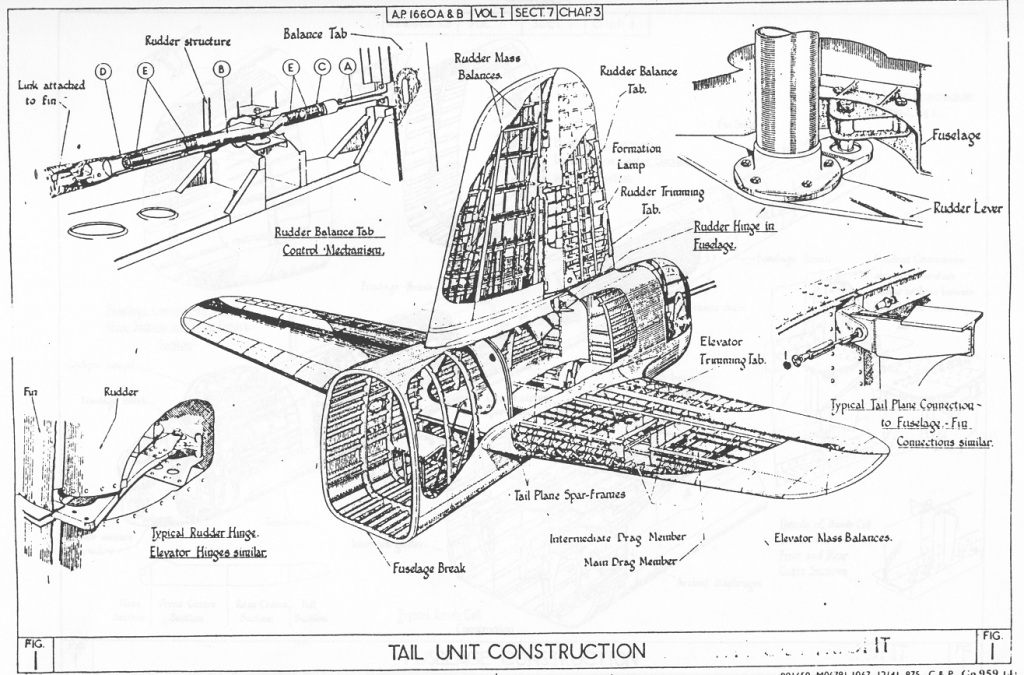
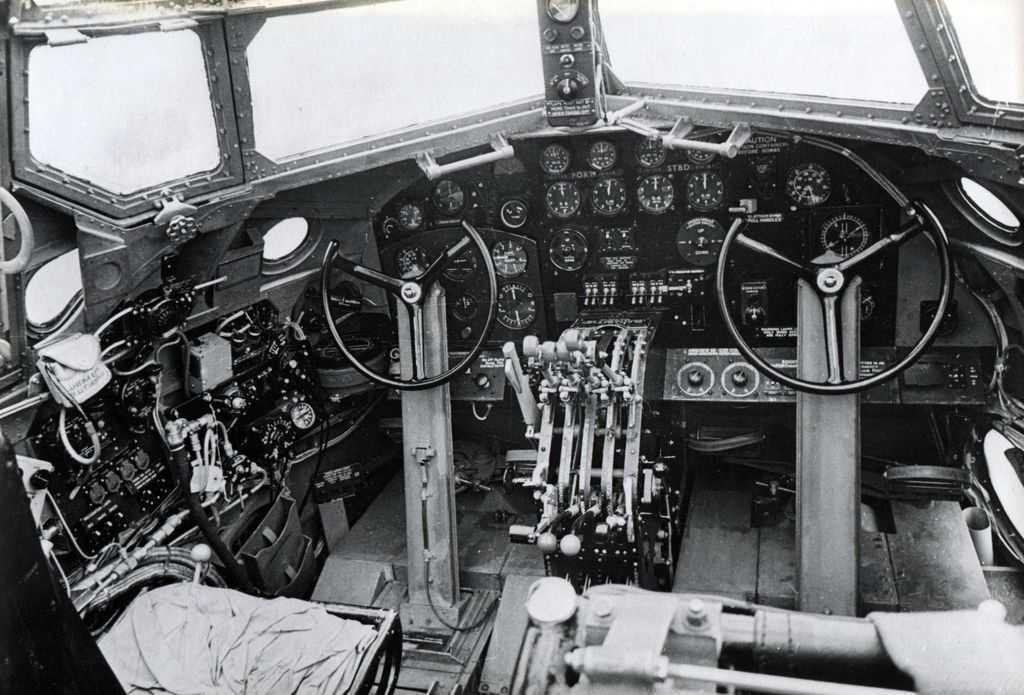
Please note that Mr. Chris Gilson, editor of "FlyPast" magazine, contacted me about this incident, and gave me some very interesting details. He is going to look out some of his research for me to include here, but basically the Air Ministry at the time were concerned about a spate of Stirling crashes where the aircraft seemed to inexplicably go out of control and plummet to the ground, some breaking up in the air. They very thoroughly investigated the Potton accident involving LK207 and it is possible determined the answer from their analysis of this incident. I will add more details when I get them. FlyPast is considering an article for their magazine; if they manage to get it done, I'll post the details here.
I have made further research into why the crash of LK207 was of such important interest to the Air Ministry at the time. This is the general story I am unearthing, but I have not been able to find an official report confirming the details, which will almost certainly have been graded as "Secret" at the time, though I would have expected any data to have been declassified and available for public viewing somewhere by today.
It may be surprising to note that of the 55,573 RAF Bomber Command crew killed in action (out of 125,000, a death rate of some 44%, a worse chance of survival than an infantry officer in World War 1), that confusingly, the records exclude crews who died on the return to the UK from a mission, even though such a loss was surely the result of enemy action. Some 5,327 crew were killed in training accidents in the period 1939-1945, but Fl/Lt Levy's test flight would not be included in that total, and I have been unable to establish a true count of evaluation and test flight losses from an operational WW2 airfield, but my personal estimate would be a further five to ten thousand men. Around every single WW2 RAF Airfield, bomber and other, would be found the sites of numerous crashes: trying to land in bad weather, or with poor experience; test flights of an aircraft which failed catastrophically; collisions between aircraft; engine failures on take-off; and many others, and quite a few without any apparent cause.
The Air Ministry was fully aware that flight evaluation losses from an operational airfield were significant losses during the war, when the aircraft and crew involved were of immense value and importance to the prosecution of the air war against Germany, as well as having a dreadful human cost. Squadrons were required to fill out a form recording the details of any such incident, and send it to the Air Ministry, where clerks would create statistics from the data. For much of the war, the losses of air crew on such flights were fairly constant across all aircraft types and the airfields they operated from. But during late 1943 and into 1944, those statistics started to indicate a higher incidence of losses in "non-operational" flights in the Stirling aircraft. Even worse, such accidents which predominently involved new crew arrivals to the squadron, were now involving highly experienced crew, whose losses on other aircraft were significantly less than the Stirling. Clearly, something was happening with that particular aircraft that was costing aircraft and crew, and even the most valuable experienced ones. Further analysis showed that a large percentage of these losses, whatever the crew experience and when the accident was fortuitously observed by witnesses, occurred to a Stirling apparently flying perfectly normally in level flight suddenly going into a nose down dive, often breaking up in the air due to the excessive forces involved, with no apparent successful attempt by the flight crew to recover the situation. And due to the circumstances of the accident, there were no surviving crew to give their account.
The Air Ministry decided to interview current, experienced, Stirling pilots for their opinion. Just about every pilot described a very annoying, and unnerving, habit the Stirling exhibited. In normal level flight, and without any warning at all, the stick in front of the pilots would sudenly go forward and the airplane enter a nose-down dive. The Ministry man no doubt pricked up his ears at that, but every pilot interviewed said that all you had to do was lean forward, grab the stick and pull it back, and the plane was restored to level flight and all was well. Since losses involved experienced crews, they would surely have simply taken that action. Even new crews when given training on the Stirling were warned by their instructors of this idiosyncracy, and how to get out of the problem. Despite the similar circumstances, it seemed unlikely to be the cause the Air Ministry were looking for. The interviewed pilots took the opportunity to moan about another Stirling annoyance: the seat belts were desperately uncomfortable when worn, so much so that many pilots wore them for take off and landing and unlatched them for the rest of the flight. To the Ministry man, simply another service moan about the equipment.
But then someone looking at the data had a eureka moment. Let's say a pilot and his co-pilot had indeed undone their seat-belt harness while flying normally, and the aircraft then decided to perform one of its nose-down antics. Could it be possible for one, or both, pilots to slide forward on their canvas seat or be thrown off the front edge, becoming sort of wedged between the metal front edge of the seat and the control column, his legs either side of it and his feet jammed onto the rudder pedals? If so, it would be very difficult to extricate oneself, the cockpit being cramped and filled with controls (see image above) it might be inadvisable to grab hold of and pull on. And it would be impossible for a pilot, even if it was only his mate jammed in that position, to pull back the control columnn and regain control of the aircraft. Yes, the suggestion was interpsersed with "mights" and "ifs", but it could just fit.
The Air Ministry immediately issued orders to all Stirling Sqaudron Administration to thoroughly investigate the causes of a "non-enemy action" Stirling accident where it was known that the aircraft had dived into the ground, perhaps breaking up in the air. To take photographs and interview witnesses in the air or on the ground, and to submit such data to the Air Ministry to a specific Section that was looking into the situation. One of the photographs taken by 161 Squadron personnel of Levy's crash appears to be the armoured back to a pilot's seat. I cannot see what significance this would have had at the time unless it was indeed the position or condition of the seat-belt, but I do wonder if the crash would have left a pilot's remains, or his seat, with clear evidence that the seat-belt was latched, or not.
The upshot was that a directive was issued to all Stirling pilots warning of the circumstances that may be an explanation of these incidents, and that they MUST wear latched seat-belt harnesses for an entire flight: operational missions; training; and evaluation. Stirling losses still occurred, but lessened to the average for other aircraft types, and such losses with experienced crew dramatically lowered. It was never "proved" that the cause of the higher incidence of Stirling losses had been finally identified, but it seems to be a good possibility to me. Did the LK207 crash at Potton fall into the category? I don't think so, as Levy had clearly managed to get some control input to the main wing ailerons to divert the wreck from the school and houses of Potton, though he may have been able to slide the column sideways even if he could not pull it back.
Short Brothers, manufacturers of the Stirling, were given two, very blunt and unambiguous, instructions by the Air Ministry. Prevent the aircraft performing the nose-down attitude, and reposition the seat-belt harness attachment points to somewhere more comfortable for the pilots when worn, even if it involved moving something else in the cockpit to allow it to happen. The latter was fairly simple even in the crowded cockpit of a large bomber. The cause of the sudden nose-down attitude was established to be the rear tail plane elevator mass balance weights somehow moving on the counter-balance arm to the tail plane itself. The weights offset the "weight" of the tail plane, meaning that the control column movement to change the elevator setting was "counter-balanced" so only required the pilot's effort to counter the force of the wind acting on it. The Stirling, along with all such aircraft in WW2, had real "fly-by-wire" controls; not electric wires or hydraulics but mechanical cables, connected through a long linkage between the elevator and the pilot's control. One final point about the last note. The photographs of the rear fuselage section are perhaps to indicate the detachment of that part of the fuselage, occurring at a fuselage manufacturing section, as shown in the sketch above. [Not very clear, I know, I am looking for a better image.] Or it might be indicating that both tail plane elevators had detached. Perhaps in the fall to earth, but perhaps somehow connected with that counter-balance problem? Why include both rear fuselage photographs in the report?
As I have already said, assuming that this story is real and not something apocryphal, then there must be records somewhere. Records of the instances of such crashes: the investigations made into them, and the reccomendations to prevent them. I am fully committed to trying to locate such data, and if I manage it, will update this web-page accordingly.
As a result of the interest shown by FlyPast magazine as described in the previous section, I contacted a friend in Potton History Society who asked around his colleagues. There is some very interesting, and poignant data, about both the Stirling accidents over Potton, this one and LK236. I will ask permission to use the photographs and data they have pertaining to both incidents when they have finished their checks of their archives and their members recollections. I don't think the data is directly accessible from their web-site, but if it is, I will make links here to it on their site instead.
The following images are contained in Potton History Society archives. I do not think the identity of the photographer is known, but it was probably someone from RAF Tempsford. The image originals are included in 161 Squadron's Operations Record Book, RAF Form 540, currently held at the National Archives at Kew under their reference number AIR/27/1068/27.
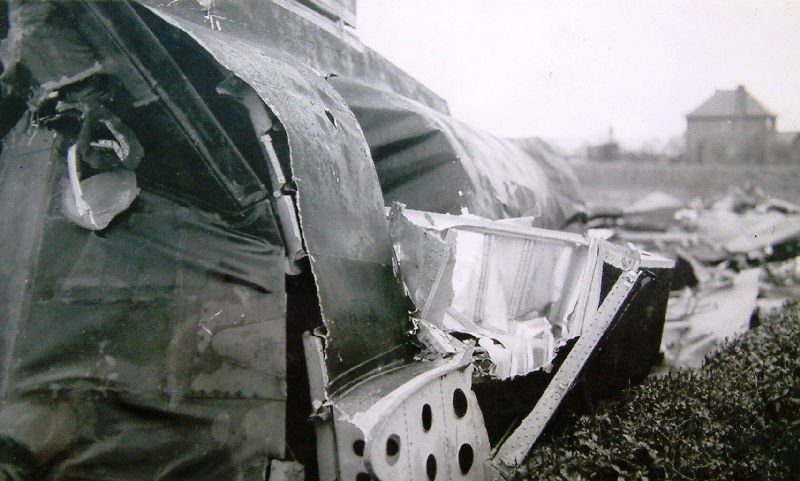
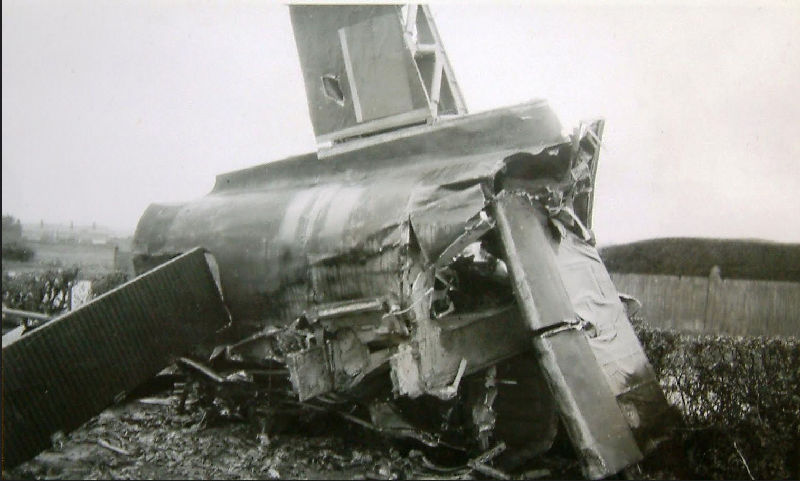
The first image is a view of the port side tail section of the Stirling, looking aft (eastwards). In the background is Mrs. Langley's house, and her nursery greenhouses, where now is Nursery Close and Langley Gardens. Some of the wreckage of the rest of the fuselage can be seen scattered on the field behind. The photographer is standing on the Sandy Road north footpath beside the hedge.
The second image is another view of the tail section, starboard side, of the Stirling, again looking aft (eastwards). In the background are the houses of Sutton Mill Road, and on the right side of the photograph is the hedge and fence that surrounded Potton Cemetery at the time. You can just see the surface of the Sandy Road between the northern side hedge on which the wreckage fell, and the southern side fence to Potton Cemetery. The distinctive vertical section on the fuselage is part of the rear tail-fin; the leading section of the fin has broken away, as has the rudder itself. The rear gunner's turret is not in place. This may have fallen away during the fuselage's descent to the ground, or it may have been removed by the recovery personnel in order to extricate the body of the Rear Gunner, Patrick Kelly. The photographer has crossed the hedge into the field itself.
Please do not use these images for your own purposes without first requesting permission from Potton History Society. Use the contact me form and I can arrange the suitable contact means.
The chairman of Potton History Society, Mr. George Howe, put me in contact with a Potton resident, Mr. John Boston, who witnessed the LK207 accident as a ten-year old lad. He and his mother had just entered the Market Square from the Doctor's surgery in King Street, when they heard a very loud bang, almost an explosion, in the air above them. They saw the plane falling, nose down in a spiral fashion and it fell to the west of the town. They went through Bull Street, Kitchener's Yard, Bull Lane, and Station Yard and saw a large piece of the fuselage lying on the ground next to Langley Nurseries and burning fiercely, with the Fire Brigade already in attendance. The tail portion had detached, and John believes it fell in Oak Crescent, he is not sure if the rear-gunner was in the canopy, or whether it was so soon after take-off that the crew had not taken up their in-flight positions as yet. He was not at school that day, but thinks some pieces may have fallen in the school grounds. He remembers the memorial service at Potton Middle School, and the dedication of the photograph of the pilot, attended by many crew family members. For many years, the photograph was on the wall of the head-mistresses office, but now, sadly, seems to have been lost. Fortunately, Potton History Society have a photograph of it, and of the back carrying the details of the dedication, so the item can still be viewed. John recalls the events vividly, as they will have made a very deep impression on a ten-year-old who had never seen the like before. I am hoping that when we get all the stories in that we can, I will be able to include the photograph on this site, or a link to it on the Potton History Society site. John also mentioned his few memories of the Deepdale crash, and the Liberator crash.
Clearly, the photographs show that the tail section of LK207 actually fell on the hedge on the north side of the Sandy Road, opposite the cemetery. Since the rear-gunner's turret is missing, it may have been that part that John saw in Oak Crescent, that is, if it detached during the aircraft in-flight break up. The newspaper report records it as an engine, but another Potton resident who spoke with me felt that the wreckage in Oak Crescent was the rear gunner's turret. The Aircraft lost on Allied Force’s Special Duty Operations & Associated Roll of Honour page 437 states that the tail and rear turret detached during the fall to earth, though that statement does not categorically make it clear if the turret remained with the tail section or separated from it. It is my opinion that the two Potton residents afore-mentioned did indeed see the rear turret in Oak Crescent.
Many thanks are due to Mr. George Howe, Mr. Peter Ibbett and Mr. David Thompson of Potton History Society, and to Mr. John Boston, for searching out data and sharing memories of the event, plus the various other Potton residents who kindly took the time to share their memories of it with me..
The Potton History Society image designation is "146-03-dnopx-1944.jpg".
The text on the back of the "Potton History Society" photograph of Flt. Lt. Levy reads: "FLIGHT-LIEUTENANT ROSS VICTOR ALAN LEVY, pilot from 161. Squadron R.A.F., from TEMPSFORD AERODROME; Home Address: Wellington, New Zealand. Pilot of Stirling Aircraft which crashed at POTTON at 11.15 a.m. on Thursday, October 19th., 1944, narrowly missing the Town after flying over this school. The plane was carrying a crew of the pilot and four others, all of whom lost their lives. In appreciation of the pilot's obvious efforts to avoid crashing on the Town, a collection was made for the R.A.F. Benevolent Fund resulting in £100 being subscribed. Receipt for this was sent to the mother in New Zealand who sent a small photograph regretting she was unable to afford an enlargement and expressing the wish that a photograph of her son be placed in this school. This enlargement was made to carry out her wishes, and a copy in colours was sent from the School to the Mother. The photographs were unveiled by Squadron-Leader Holdcroft, Administrative Officer of the Tempsford Aerodrome, on Tuesday, 3rd., July, 1945, in the presence of Flight-Lieutenant Moffat, N.Z.A.F. and three other R.A.F. officers. Mrs Kelley, mother of the Rear Gunner who lost his life in the crash, the School Staff and scholars with Miss Bevan, Head Mistress of the Primary Dept. and some of her scholars, and the School Managers were present. (Signed) Thomas H. Williams. Head Master." [I am not sure which spelling for Patrick Kelly/Kelley is correct - a transcript from the 161 Squadron Operations Log records it as the former, the photograph text as the latter. I have been unable to unearth any information about this gentleman. It is very sad that the originals of these photographs have been lost.]
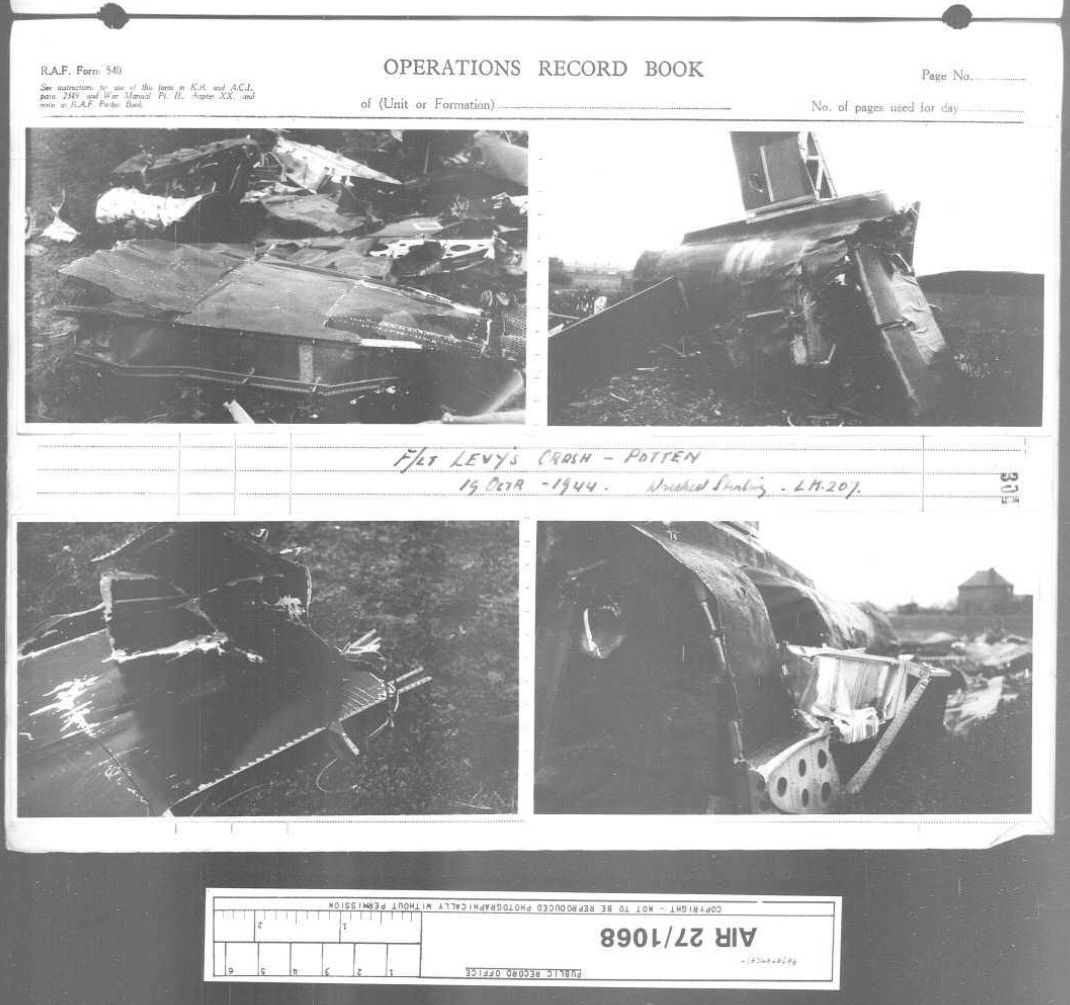
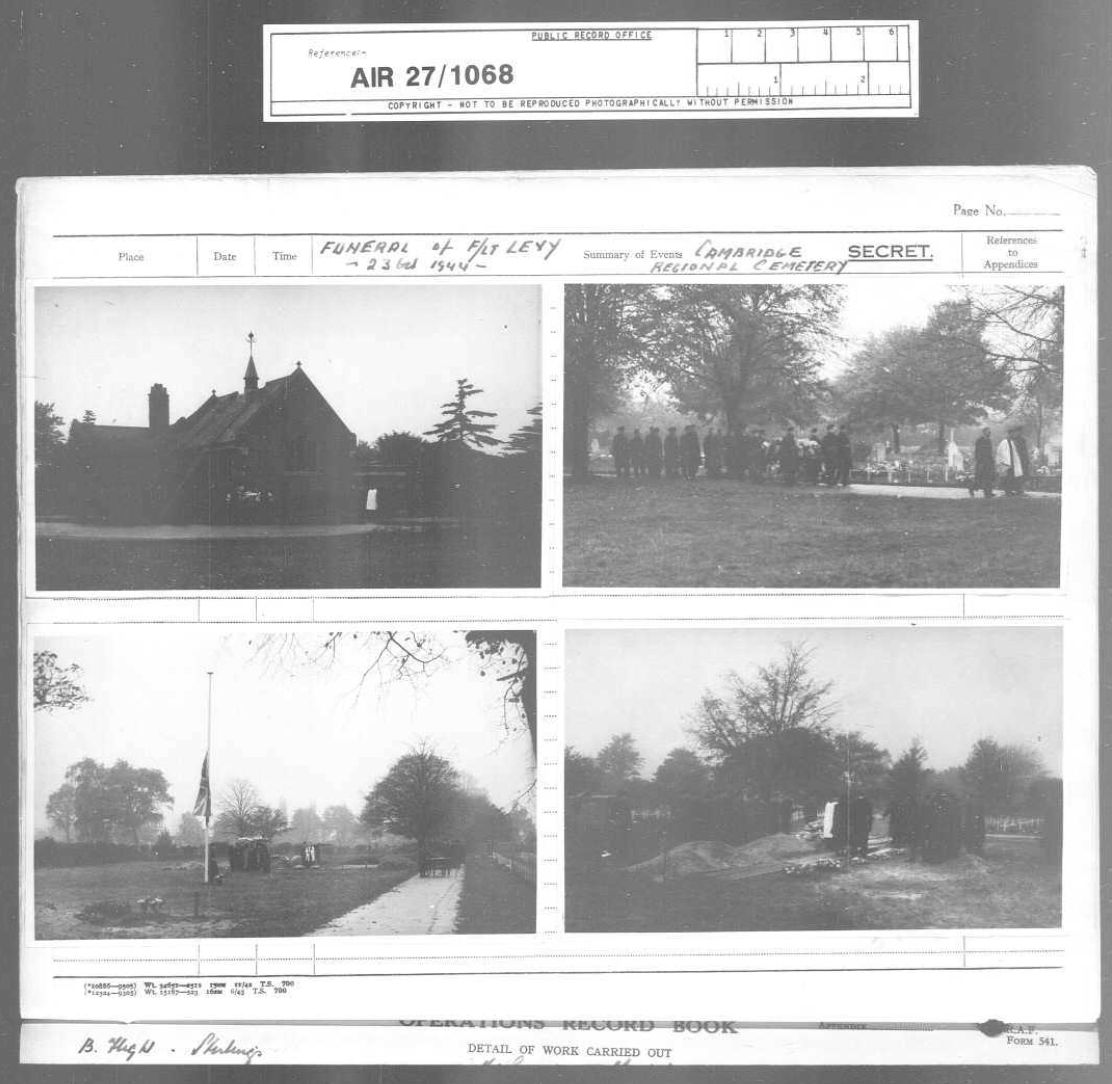
The images here are taken from scans of the 161 Squadron Operations Record Book, National Archives reference Air/27/1068/27. When I next visit the Archives, I will attempt to make a better image of the pages.
The local schoolmaster wrote to Mrs Ludlow, F/L Levy's mother saying "You've no idea what we thought when we saw the plane heading for the school, with 300 children. Your son managed to hedgehop the plane away from the schools."
Another letter from the local vicar at Potton's St. Mary's church expressed the town's gratitude "...for the cool courage and strenuous effort and great skill of the pilot who steered the fast-disintegrating plane over the school into a field beyond, and so protected them from harm and death."
I assume Levy's mother had at some stage married for a second time to a Mr. Ludlow.
Ross (Allan) Levy was a New Year's baby, born 1st January 1923 to parents Lionel John and Henrietta Levy of Northland, Wellington, New Zealand.
I do not know the professions of his parents or family, nor what he did before enlisting in the Royal New Zealand Air Force in 1942 at the age of 19 years.
Ross embarked from New Zealand on the World War 2 Dutch Troopship, "Bloemfontein". It is known the vessel sailed from Wellington for San Francisco, arriving in early March of 1942. She made another voyage from Wellington reaching San Francisco on 31st August 1942. She subsequently made many voyages in the Pacific Ocean, and passed through the Panama Canal for trips to New York and Liverpool in the United Kingdom. It seems likely that Ross made the trip to California in the States sometime in 1942 on one of the two voyages I have mentioned in that year.
He was eventually sent to the Royal Canadian Air Force (RCAF), Number 2 Service Flying Training School, Uplands, Ontario where he graduated Course 1: Class 75. on 11th June 1943. He also spent time at RCAF, 13 Service Flying Training School, St. Hubert, Quebec.
The above data from the Auckland Museum Cenotaph site.
His RAF career is currently uncertain before he joined 138 Squadron at RAF Tempsford where he was made Flight Lieutenant, transferring to 161 Squadron on the same base in September 1944. Anyone who has attempted to obtain the Service Records of RAF personnel will know that they are only available to the personnel themselves, or immediate surviving next-of-kin.
Other crew membersOther than in the paragraph below regarding Flt. Srgt. Coveney, I have been unable to unearth any data pertaining to the other members of the crew of LK207 on that day. It is my belief that Flt. Srgt. Coveney and Srgt. Kelly were almost certainly usual members of Levy's crew, and that P/O Atkinson and F/O Stigger were either there on that particular flight to carry out flying evaluations and duties, or had "begged a trip" with Levy, as commonly happened among flight crews when a pleasant day-time flight in the airfield's vicinity (away from enemy action) was on offer. However, both these latter two gentlemen had been on Flt. Lt Levy's last operational flight:
From 161 Squadron Operational Record Book, reference "AIR27/1068/26", the last operational flight I could find that was captained by Flt Lt Levy, was in Stirling "T" on 30th September 1944, with the following crew:
Flt Lt Gunton
Flt Lt Harley
FO Stigger
?? ??????
F Sgt Coveney
Sgt Atkinson
Sgt Kelly
PO ?????? (possibly Fust or Hurst)
Operation "BIT 7". Flight times "2100 to 0330, 7.30 hrs". Recorded as "completed", with some text possibly referring to "Norway" as the operation destination, and the note: "Reception was found after (?) from STRAND (?) (?) lake at 2334 hrs. 12 containers and 9 packages dropped." The flight duration is either wrong, or one of the depart/return times. I'm guessing "Reception" refers to the group in Norway waiting to receive the drop. There were a few operations to Norway at the time, but I have been unable to identify the lake or its location. It looks a bit like "Lisa" or "Lesa". I also do not know the Stirling ID that Levy usually pilotted.
Flt Lt William Walter GUNTON (115781 or 450817), RAFVR, was gazetted "Acting Squadron Leader" of 161 Squadron 17th August 1945. I think that would suggest he fortunately survived the war.
I have been sent some fascinating data about one of the crew members, Flt. Srgt. Albert Coveney. Jaimie McDermott (his great-nephew), who has Albert's pocket watch and compass, both found on his recovered body and still working, and has kindly supplied photographs, reproduced here.
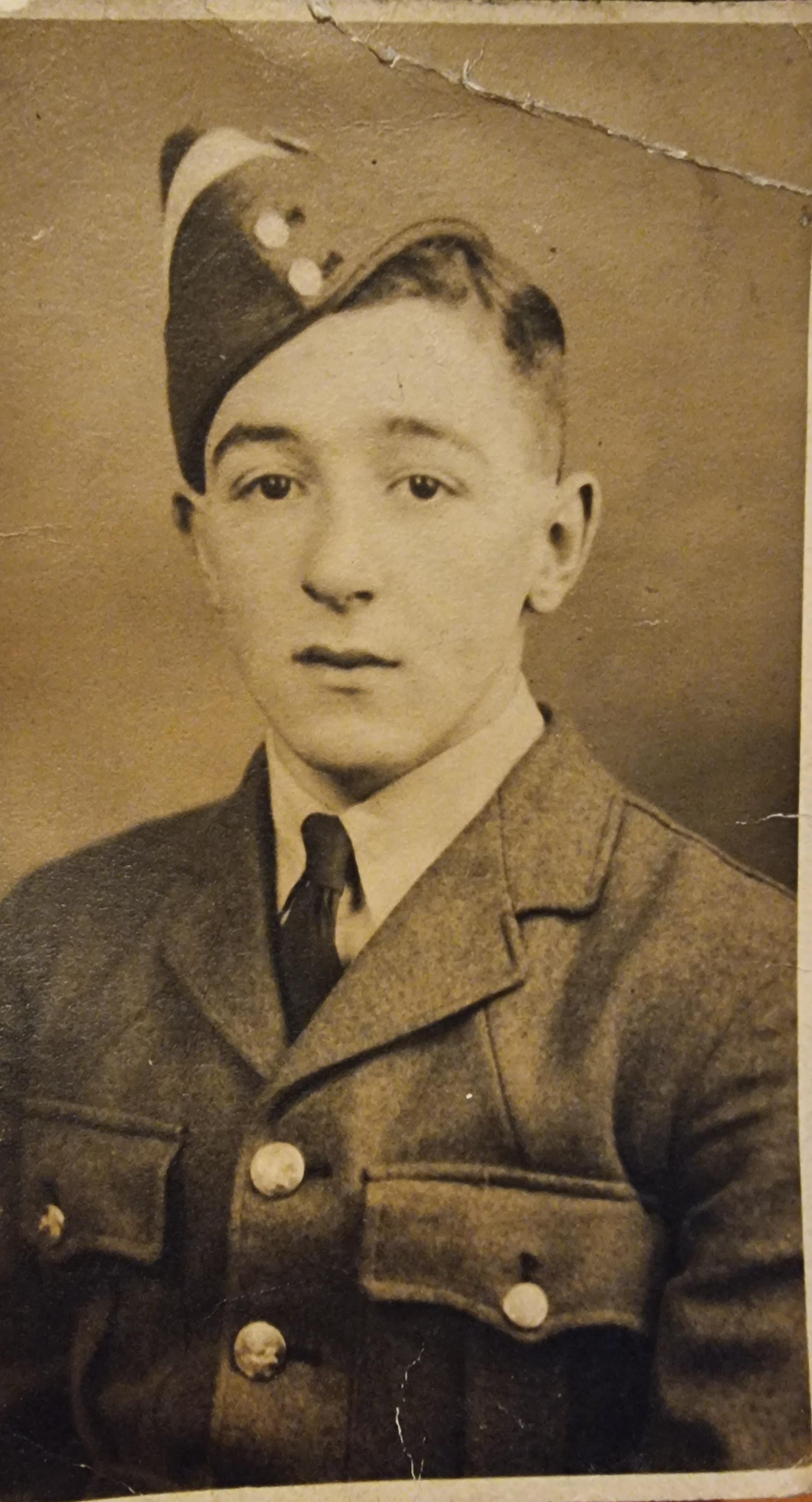
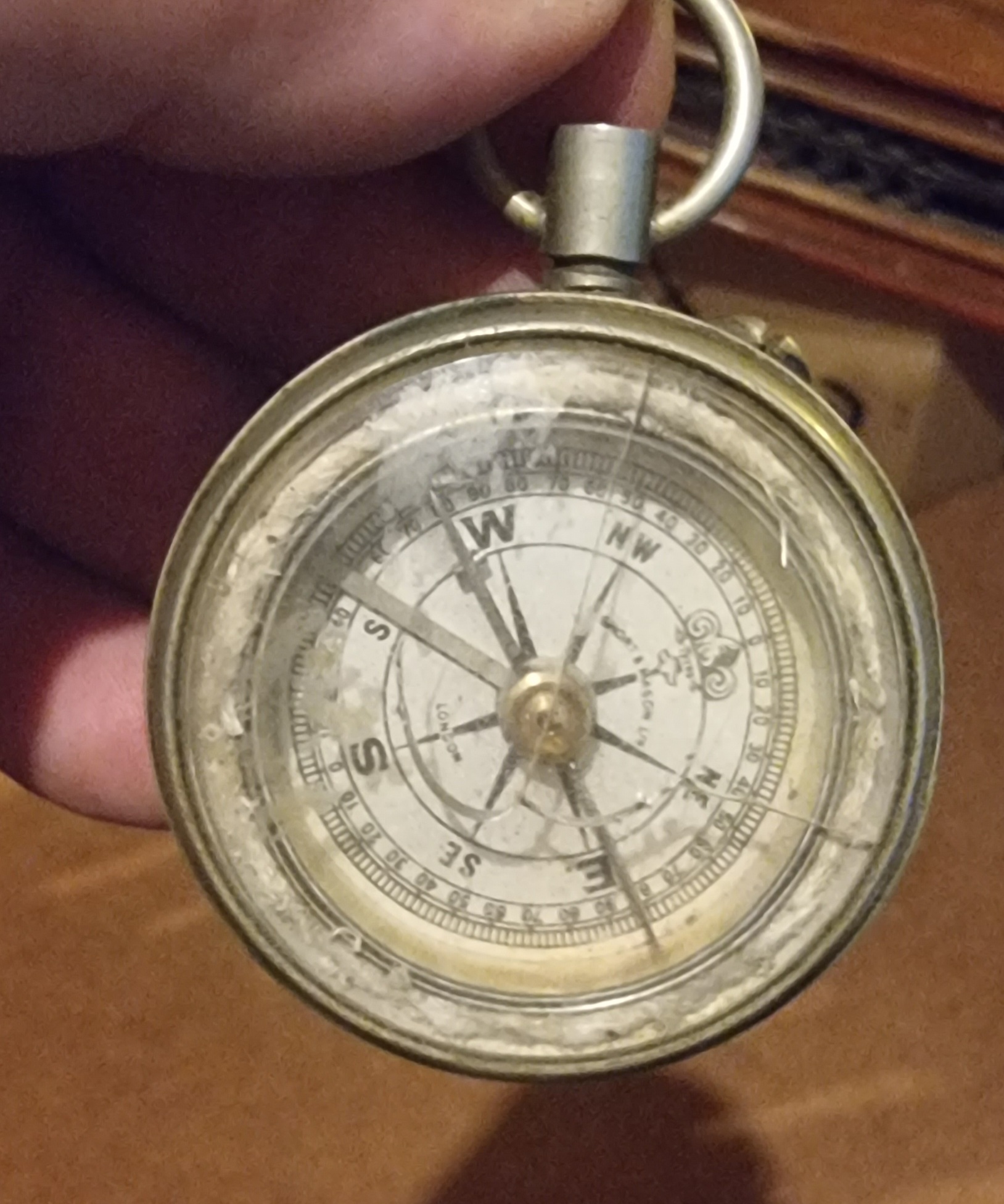
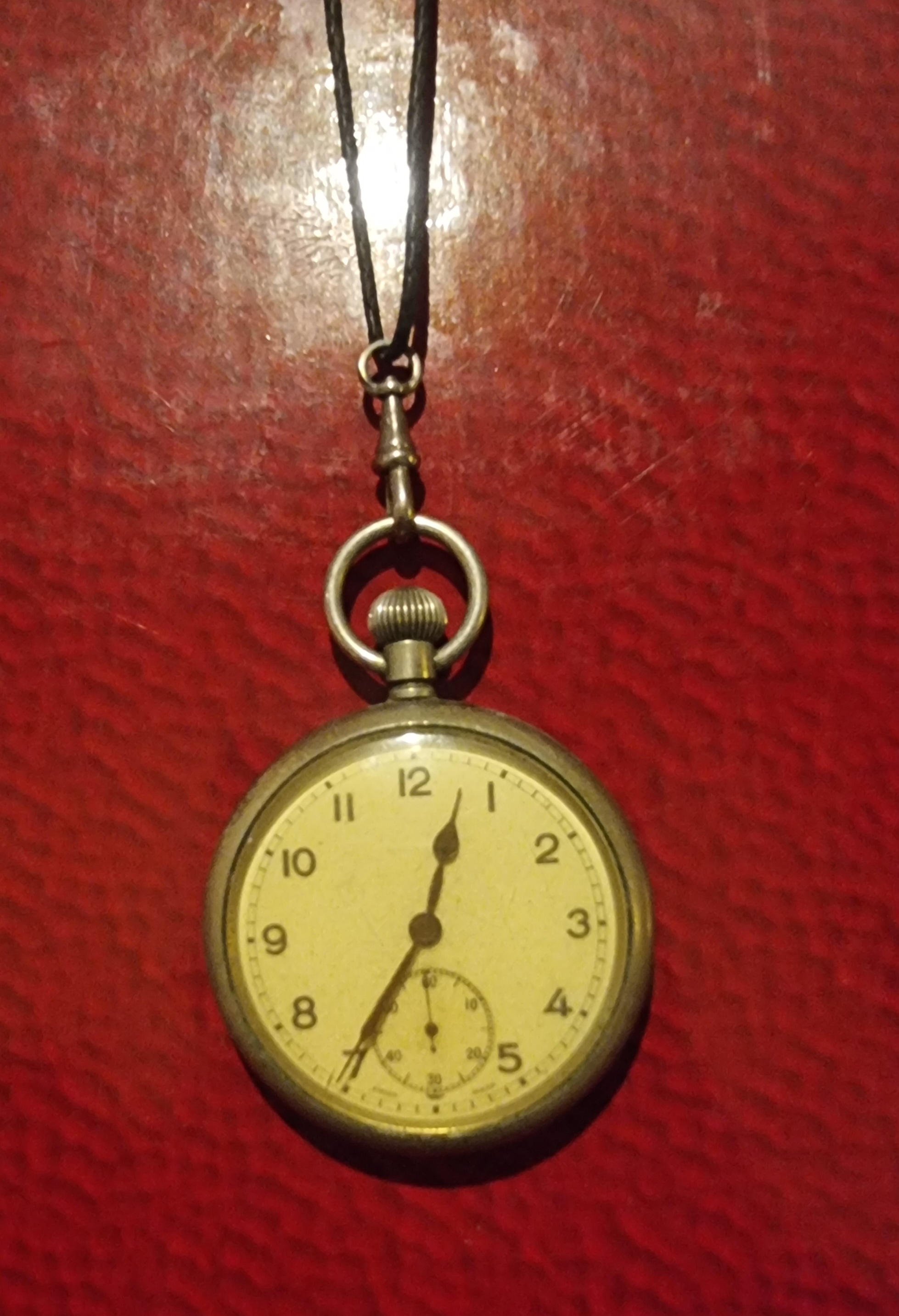
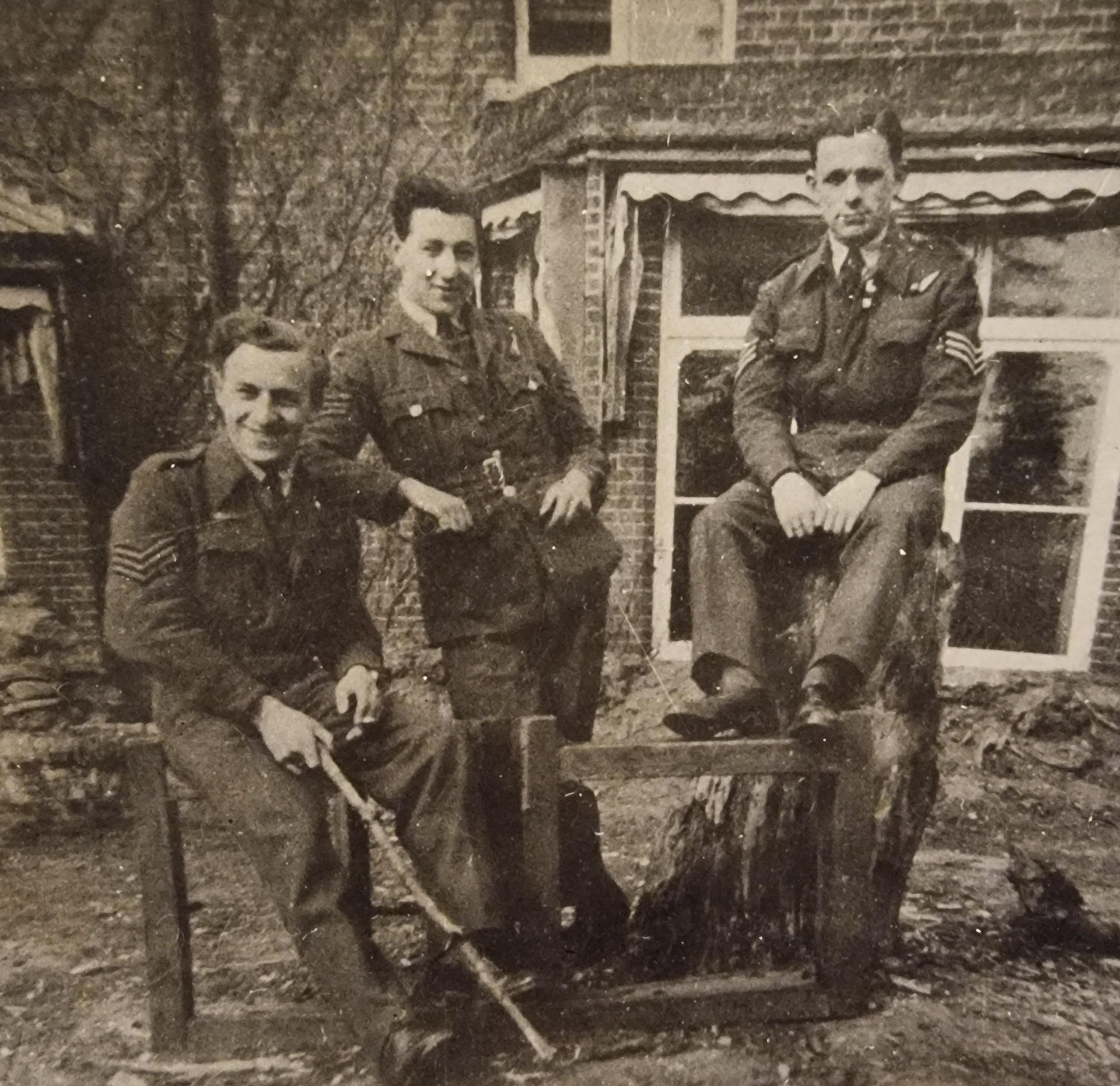
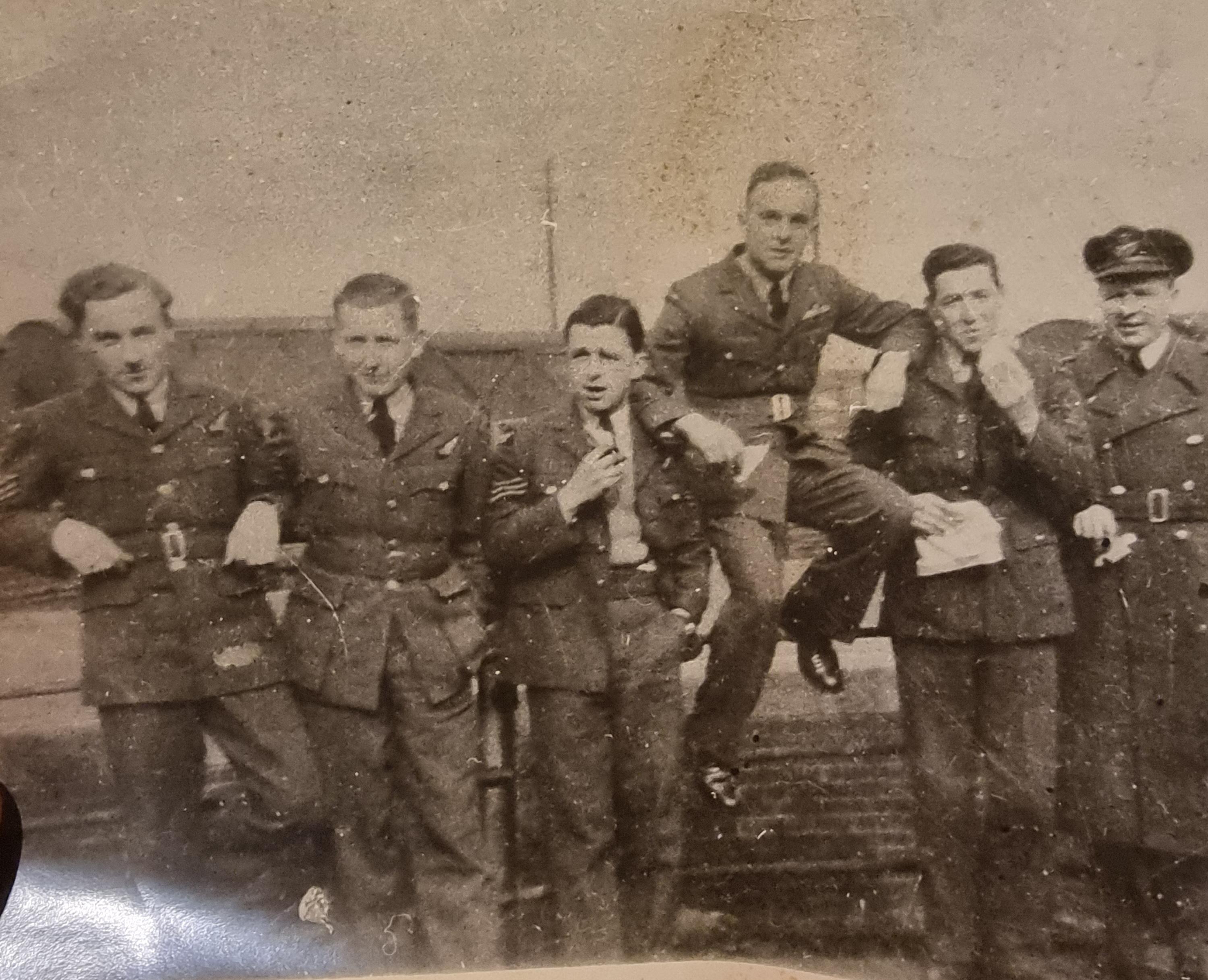
It seems very likely that the group photographs are members of the crew of Flt. Lt. Levy's usual Stirling aircraft before he took LK207 up for its ill-fated trial flight after the heavy landing on delivery. Jaimie says Albert is the gentleman second from right in the group of six. I think Albert is also likely to be the middle sergeant in the group of three photograph. As ever, if anyone who happens onto this page can identify any of these crew, and even supply some notes about them, please contact me via this link: contact me.